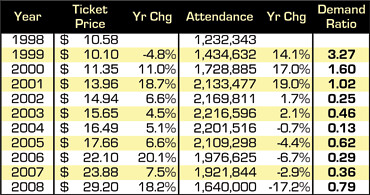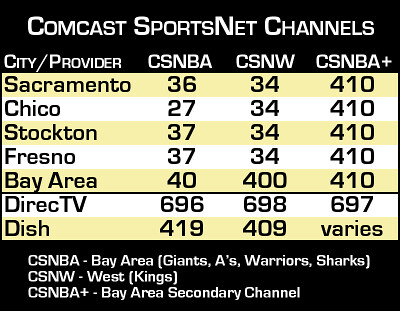The comments thread had a nice exchange regarding inelastic demand. What does inelastic demand mean? Simply put, it's a lack of demand change for a product relative to price change. The formula for demand elasticity looks like this:Blez: I’m going to get to the tarp and the Coliseum a little later, but how do you sell a team that is in rebuilding mode to a market that at times can be ambivalent? The Coliseum wasn’t even selling out when the A’s were the class of the AL a few seasons back. Does it take a World Series victory or even two to motivate these fans again? Or is this just a dead market?
Wolff: I do think that the proximity between us and the Giants hurts. They’ve actually moved closer to us. The six years prior to the year 2000, the Giants outdrew us by around a half a million on average per year. In 2000 they opened the new ballpark and the attendance has jumped and pretty much has stayed there. The difference is now about a million and a half although I haven’t checked it this year. That (the new venue) has something to do with it. Maybe not 100 percent. Secondly, Barry Bonds was a big attraction there and we didn’t have Barry Bonds. The other side of it is the demographic. Both the Giants and ourselves have a lot of water in front of us so there isn’t anyone else living there. A couple of other owners tease us that we may be the only inelastic demand team in baseball. That means that if you won the World Series, the next year would you have two and half or three million out there? In other words, our band of attendance has been approximately 1.7-2.1 million, win or lose that’s where we’ve been.

When the value (absolute value) of this coefficient is between 0 and 1, demand is considered inelastic. You're probably wondering what how the A's demand has looked recently. To that end I compiled a table showing the FCI average ticket price and annual attendance (2008 attendance projected):

You can see that from 2001 forward, the demand ratio (coefficient) has been less than 1 or less, hence inelastic. This is despite a 102% hike in ticket prices in that timeframe. The rich teams have unique market positions. The Yanks, Mets, Red Sox, and Cubs are effectively monopolies. That's how they can continuously raise ticket prices with zero effect on demand. They are the antithesis of the A's. As long as the A's are in the Bay Area, they will always be in a competitive position, not a monopoly position.
So why has this happened? We've gone over most of the reasons in great detail. The Coliseum is long-in-the-tooth, disaffection from long-time fans, the Giants moving closer and poaching casual fans, on-field performance, susbtitute entertainment options, etc. ad infinitum. Is it a reason to abandon the market? Of course not. This market is plenty big enough for six or seven major sports franchises as long as they have good venues and are located properly. In light of this, I don't expect the current business model at the Coliseum to change much in the remaining years of the lease - no untarping the third deck, no cheaper beer or concessions, no ticket price freezes. There's little impact to project from such moves, and thus little reason to make any moves.

